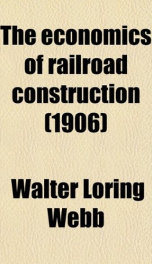the economics of railroad construction

Purchase of this book includes free trial access to www.million-books.com where you can read more than a million books for free. This is an OCR edition with typos. Excerpt from book: CHAPTER III. CAPITALIZATION.. 12. Stock.The total railway capital of the roads of the country, as reported to the Interstate Commerce Commission for the year ending June 30, 1904, aggregated $13,213,142,679. This capitalization was at the average rate of $64,265 per mile. The capitalization represented stock to the amount of $6,339,899,329, which is 47.98% of the total capitalization. This is slightly less than the percentage in previous years, although during the last eleven years this percentage has only varied from 47.44 to 50.87%. The average amount of sock per mile of line for that year was $30,836. This value has been singularly uniform for many years past in spite of the large increase in the mileage. This total issue of stock is divided into common and preferred stock, of which the preferred stock for the year given was $1,289,369,860, which was a little over 20% of the totefl. Preferred stock usually carries the right to a dividend at a fixed percentage, which dividend must be paid before any dividend can be declared on the common stock. Frequently, although not always, these dividends are cumulative, which means that if for a period of one or more years the railroad is unable to pay them, the defaulted dividends constitute a lien on the road which must be paid ultimately before dividends may be paid on the common stock. This stock therefore occupies an intermediate place between a bond and the common stock. It carries with it no authorization to foreclose andsell the road in order to secure a payment of either principal or interest, but, on the other hand, the interest or dividends, although definitely limited in amount, have a priority over the payment of any dividends on the common stock. Although the capital stock per mile of line for the whole United States...
Info about the book
Author:
Series:
Unknown
ISBN:
0691047006
Rating:
5/5 (4)Your rating:
0/5
Languge:
English
Users who have this book
Users who want this book
What readers are saying
What do you think? Write your own comment on this book!
write a commentif you like the economics of railroad construction try:
Do you want to read a book that interests you? It’s EASY!
Create an account and send a request for reading to other users on the Webpage of the book!



